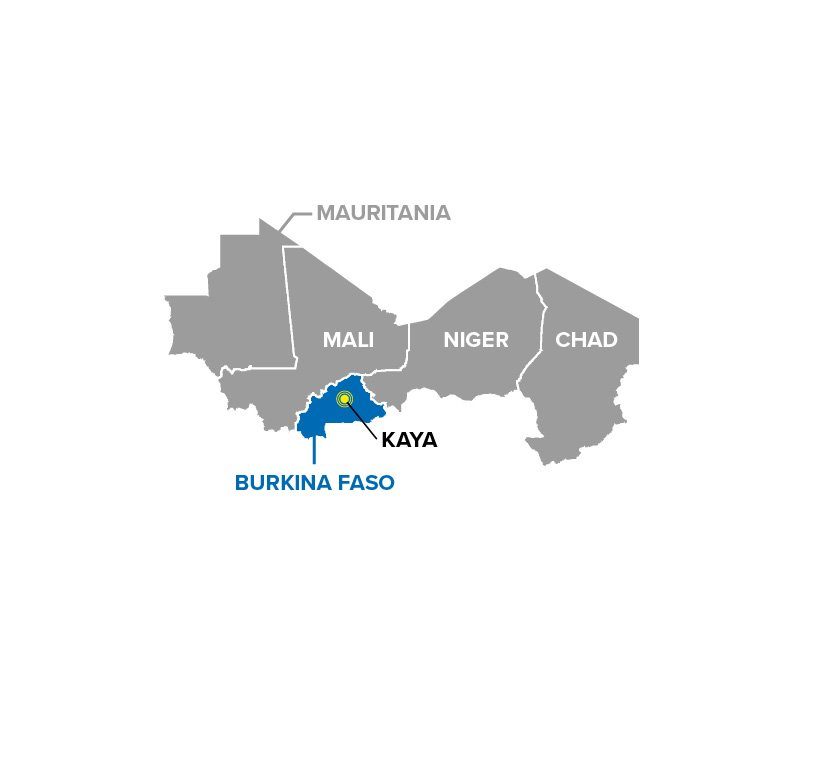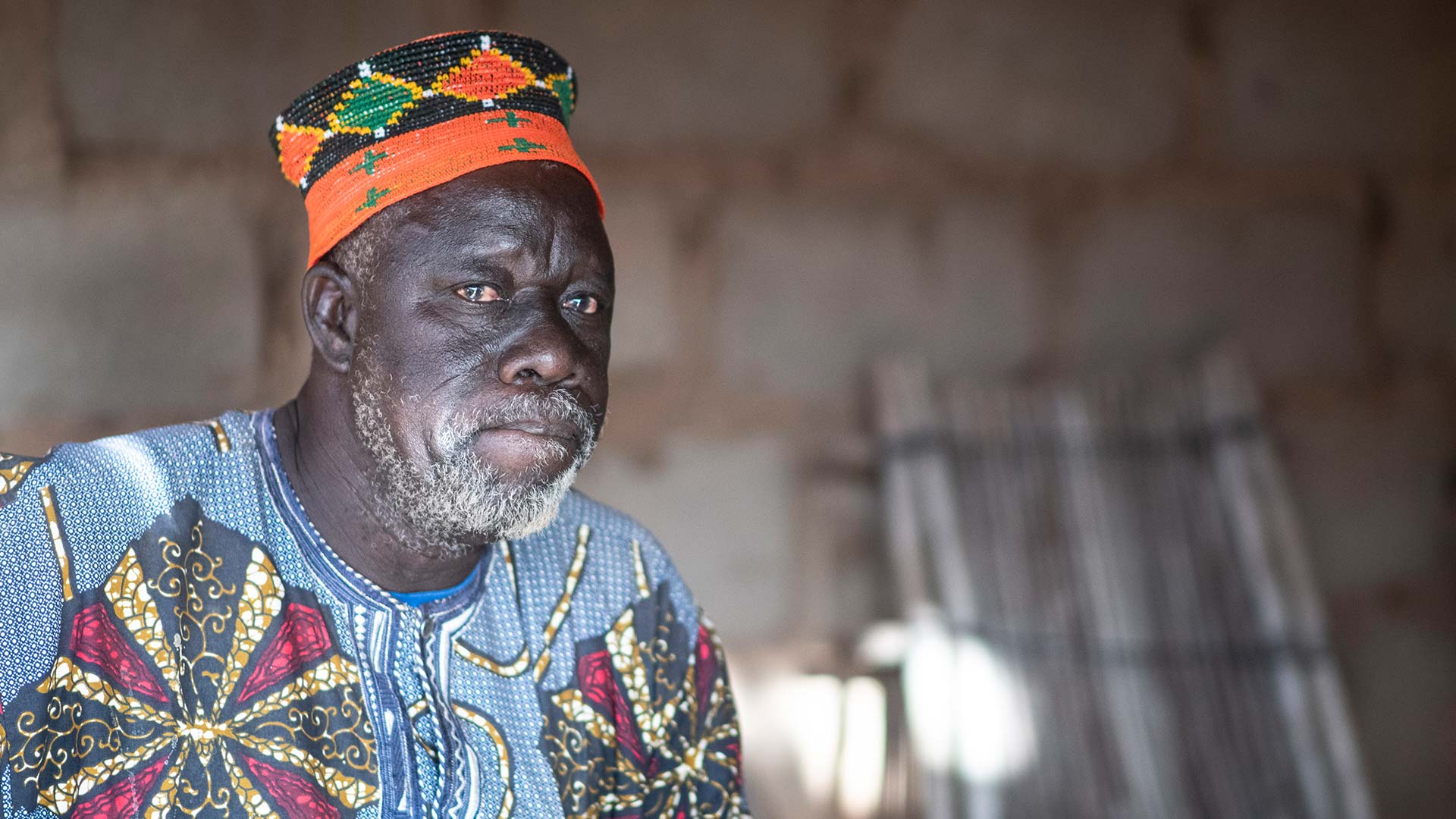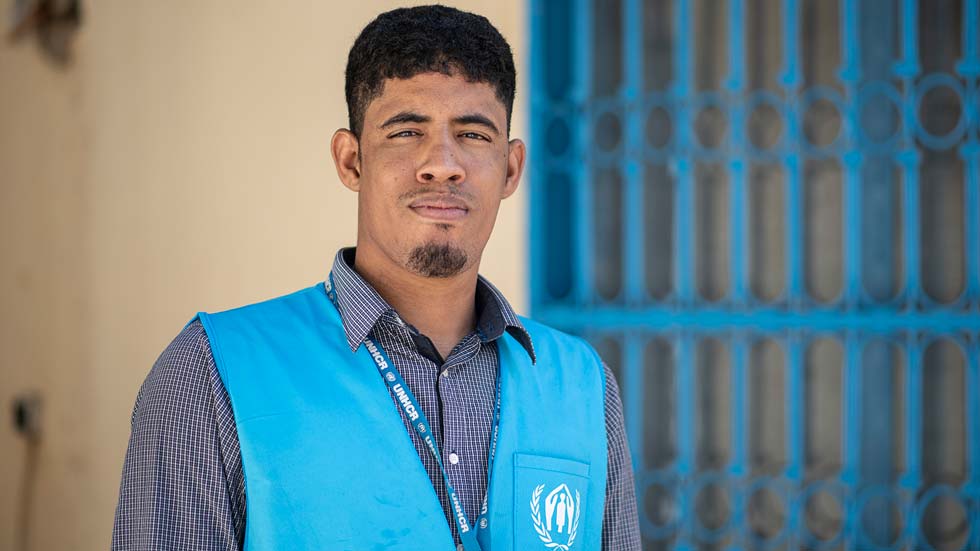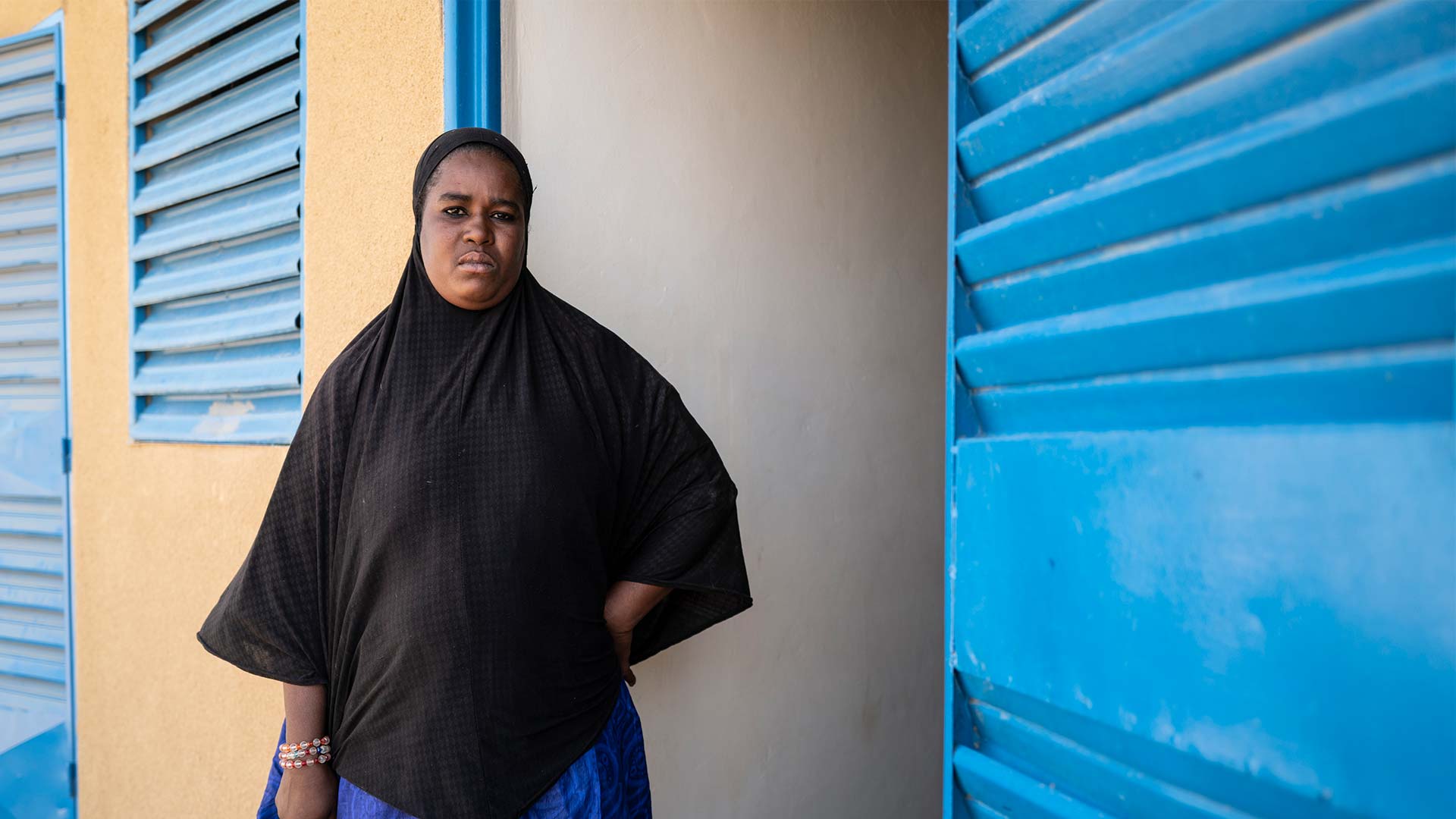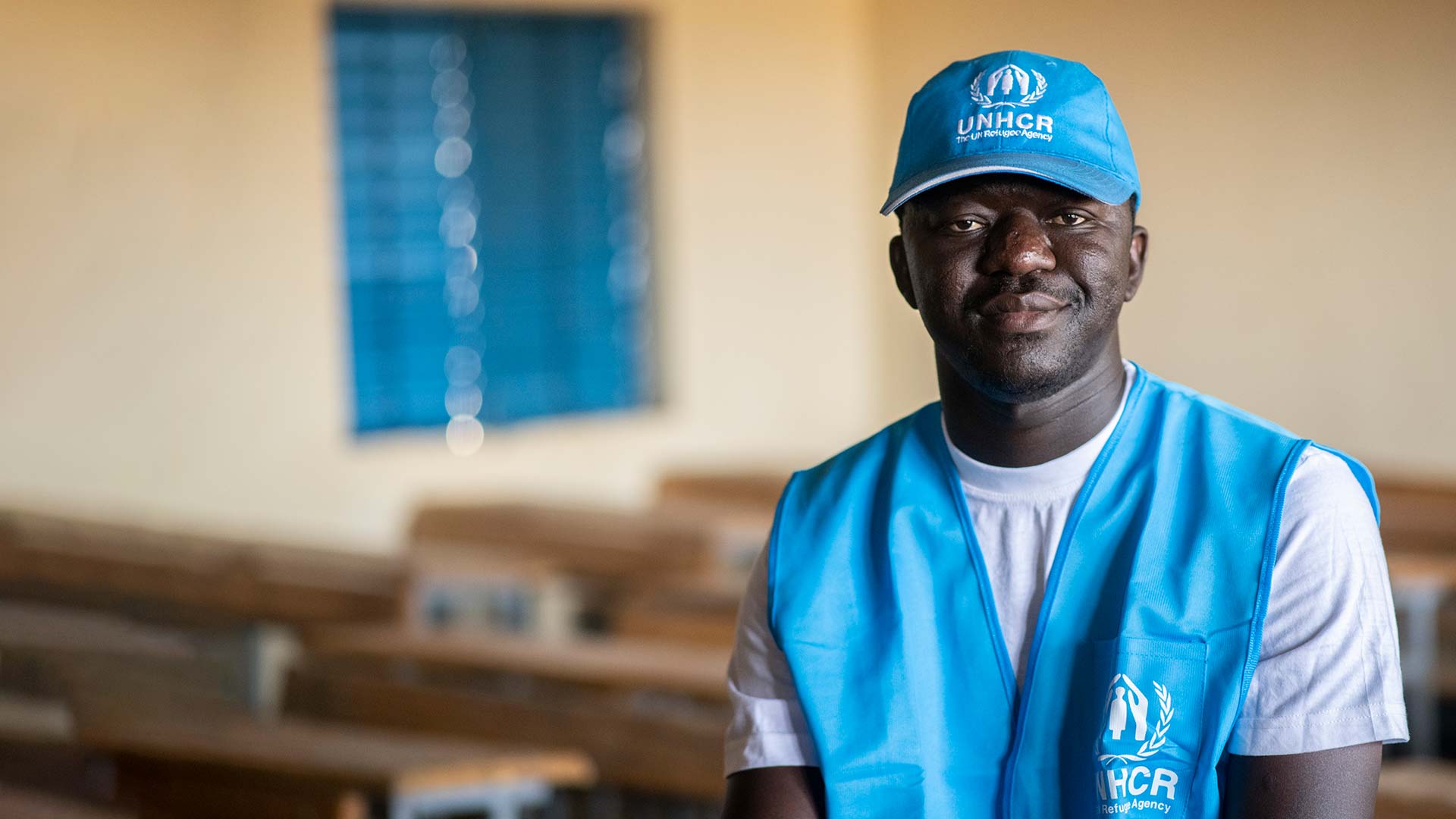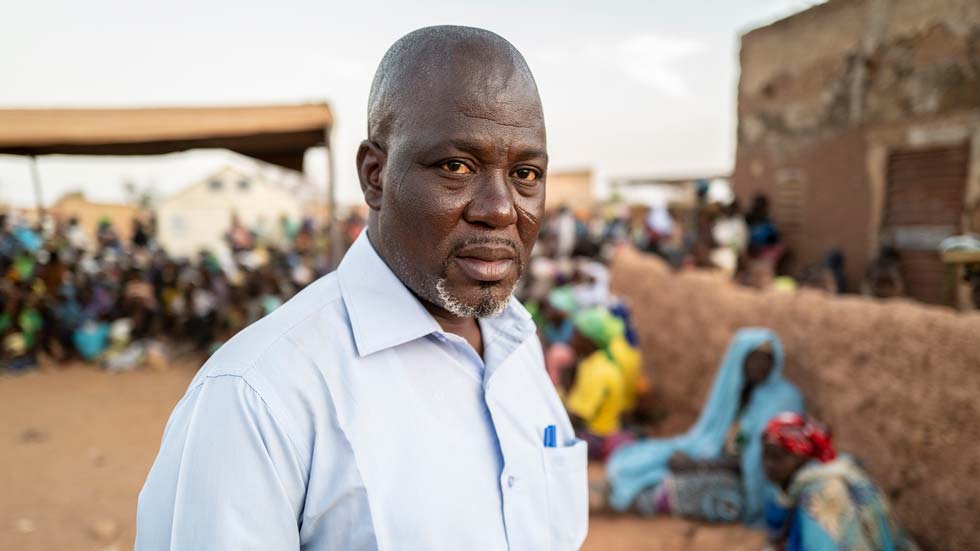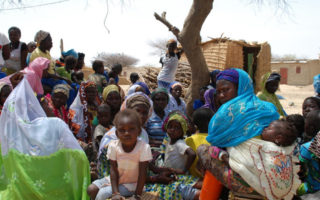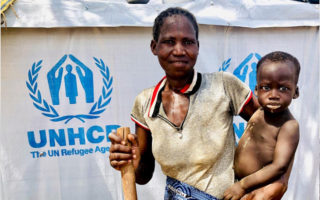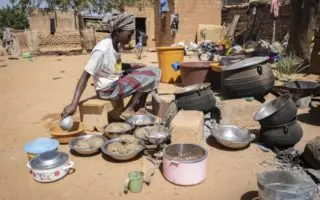
Zeinabou, 42, photographed in her relatives’ courtyard in Burkina Faso. Three days earlier, her husband was killed before her eyes.
Text by Kathryn Mahoney
Photos by Sylvain Cherkaoui
In Burkina Faso, almost nowhere is safe.
Armed groups, extremists and criminal gangs wage terror on a daily basis, murdering those who refuse to fight alongside them. The killers shoot families to death. They rape and torture women. They destroy anything that symbolizes the state: schools, police stations, even hospitals.
Those who survive an attack know they might only be lucky once, so they run. In the past 15 months, 800,000 Burkinabè have fled their homes to seek safety. Some cross into Mali or Niger, where conditions can be just as perilous. Others look for shelter within Burkina Faso. But as the violence spreads, many are fleeing for the second and third time.
Daily life in Burkina Faso, a landlocked nation of 19 million, is precarious. Meet six people – photographed and interviewed in early February 2020 – whose lives have been turned upside down.
The violence in the Sahel – an arid belt that stretches for thousands of miles along the southern edge of the Sahara – erupted after the 2011 revolution in Libya and a 2012 uprising in Mali. Armed men swept across borders, exploiting ethnic tensions, poverty and weak governance to terrorize local populations. When the bloodshed reached Burkina Faso, roughly four years ago, it ended the peace the country had long known.
For years, people escaping conflict in neighbouring Mali fled to Burkina Faso, and some 25,000 refugees lived in camps across the country. Many of these settlements have come under attack more than once, and the threat of violence makes it nearly impossible for aid workers from UNHCR, the UN Refugee Agency, and other organizations to reach some of the refugees. It has also become too dangerous to keep markets and schools open. Jobs are disappearing.
The refugees face an impossible choice: stay and risk being attacked, or return home to a country still in turmoil. Some are going back to Mali, even to areas so dangerous that humanitarians and national defense forces cannot enter.
Now Burkinabè are taking in their fellow citizens. But communities are at a breaking point. Already struggling with poverty, failing schools and a fragile health system, they now face an additional threat: the new coronavirus.
To slow the pandemic, borders have been sealed and schools closed, a curfew has been imposed from 19:00 to 05:00, movement is restricted to and from towns with confirmed cases of COVID-19, and gatherings of more than 50 people are banned.
Internal Displacement in the Sahel
838,548 Displaced inside Burkina Faso
218,536 Displaced inside Mali
226,700 Displaced inside Niger
The Survivor
“I’m so traumatized that I can’t even remember what happened. I don’t know what I’m saying.”
– Hawa, 57
Hawa buried the dead the next day, then fled with 32 members of her family. Now she has found relative safety at her son’s home in Kaya, 150 kilometres to the south. But she has nightmares, waking up each night screaming, phantom gunshots ringing in her ears. “I am a widow of this conflict,” she said.
“Nothing prepared me for what I saw in Burkina Faso… I was particularly struck by the plight of so many women who had suffered violence, whose husbands had been taken away from them or killed, whose children had been separated from them.”
– Filippo Grandi, UN High Commissioner for Refugees, on France24
The Welcomer
“As a chief it is my duty to take in those who come to me for help.”
– Dianbendé, 67
Community leader Dianbendé now hosts more than 2,500 displaced Burkinabè on and around his property, a number that mounts each day. He offers food, shelter and water – often at his own expense. With one bad leg, he moves with difficulty and has trouble providing even for his family but welcomes every arrival.
“At first we thought they were only killing men. But then we realized that they would kill women and children too,” Dianbendé said. “I’m disabled. I have nothing to give. But it is my obligation to try to make this situation even a little better.”
Displacement in Burkina Faso has risen tenfold in the past year, surpassing 800,000. More than 90 per cent of the displaced live with host families, and UNHCR estimates there are still more than 35,000 families in need of shelter in the country.
The Volunteer
“The refugees tell me what I do is noble, but honestly I’m scared. I take these risks because I love my job. I’m committed to defending our human rights.”
– Ilyas, 30
Ilyas works for UNHCR under the UN Volunteer Programme in Djibo town and Mentao refugee camp in the north of Burkina Faso. Conditions are so risky that he is one of only two UNHCR staff there. He helps ensure that refugees have access to food, water and shelter. As a Malian refugee, he feels honoured to work for UNHCR, but fears it could make him a target.
Armed groups in Burkina Faso have killed government officials, health-care workers, teachers and other symbols of the state. At times they have targeted humanitarian organizations too, stealing vehicles and kidnapping staff.
The Mother
“My daughter panicked when she heard the bullets and now she panics all the time. All I wish for is one day when my daughter doesn’t have a panic attack.”
– Leila, 30
Leila fled violence in Mali in 2012 and lived in Goudoubo refugee camp until 2019, when armed men on motorcycles attacked the camp three times.
Leila’s ten-year-old daughter, Rahmata, witnessed one of the attacks and has never been the same. Leila says she herself has been “profoundly” affected by the number of people showing signs of psychological distress amid rising insecurity.
“It really hurts. It’s hard to be a mother and see this,” she said. “I just keep praying for peace.”
Until the latest upsurge in violence, nearly 9,000 refugees were living in Goudoubo, but about half have since returned to Mali while the rest moved to other places in Burkina Faso. The camp is now empty.
The Humanitarian
“This hurts me. My country is under attack and we can’t give people the protection they deserve.”
– Eric
Born and raised in Burkina Faso, Eric works as a UNHCR associate registration officer in the country’s north-east, not far from the borders with Niger and Mali. He had worked in Goudoubo camp since 2012, when Malian refugees began seeking safety in his country. He feels a kinship with the refugees he serves.
“I have been a brother to the refugees, and them to me,” he said.
Now that the conflict has spilled into his country, Eric says the refugees are offering him support. They empathize with his sadness. Now that the areas where refugees are living is more dangerous, Eric cannot see them as often, if at all. He feels “weak and worried.”
A UNHCR study found that 38 per cent of its staff worldwide working directly with refugees or displaced people were at risk of secondary traumatic stress, a disorder that can bring on physical, mental and emotional exhaustion.
Prevalent among people who work under emotional stress for long periods, the disorder can make it impossible to carry out normal daily functions and cause negative feelings about oneself or the world.
The Local
“This has turned our life upside down, but we cannot turn them away. What would we do, tell them to leave to go get killed?”
– Yobi
Yobi Sawadogo is an advisor to the mayor of Kaya, a town that counted 66,000 residents in its last census (in 2012) and now hosts more than 300,000 displaced Burkinabè. The local government welcomes people in need, but the influx of newcomers has drastically changed daily life. The lines to fetch water are growing longer, and health centres are becoming overcrowded. Markets are still well stocked, but only because those who fled here have no money to buy food.
In spite of the challenges, Yobi said his town will continue to accept those who seek safety, partly out of solidarity and partly out of fear. “We say that what happened to them could happen to us,” he said, “We can’t turn people away.”
Until 2016, Burkina Faso was a model for relatively peaceful co-existence among ethnically diverse communities, and a safe haven for refugees. The violence there is unprecedented, and the government is grappling to manage the scale of humanitarian needs. But for now, many are still sleeping outdoors, exposed to the elements and other dangers, and in acute need of better access to water and sanitation facilities.
UNHCR and other UN agencies have called for US$255 million globally to support government efforts to combat COVID-19 in areas hosting refugees and IDPs.
To support our work in the Sahel and other regions grappling with displacement and coronavirus, donate now.
Originally published on UNHCR on 17 April 2020.



